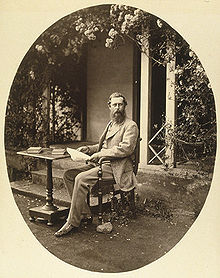Samuel Bourne
| Samuel Bourne | |
|---|---|
 |
|
| Born | 30th October 1834 Staffordshire, England |
| Died | 24 April 1912 |
| Occupation | Photographer |
| Style | Landscapes, Ethnographic Portraits |
Samuel Bourne (30 October 1834 – 24 April 1912) was a British photographer
known for his prolific seven years' work in India, from 1863 to 1870. Together with Charles Shepherd, he set up Bourne & Shepherd first in Shimla in 1863 and later in Kolkata (Calcutta); the company closed in June 2016.
Samuel Bourne was born on 30 October 1834, at Napley Heath, near Mucklestone, on the Staffordshire & Shropshire border to Thomas Bourne (b. 1804) and his wife Harriet née Dobson (b. 1802). After being educated by a clergyman near Fairburn, he secured a job with Moore and Robinson's Bank, Nottingham in 1855. His amateur photographic activities started at about this time and he quickly became an accomplished landscape photographer, soon lecturing on photography and contributing technical articles to several photographic journals.
In 1858, Bourne made a photographic tour of the Lake District, and in 1859, displayed photographs at the Nottingham Photographic Society's annual exhibition. The following year, his photographs were also shown in London, at the London International Exhibition of 1862. This reception he received motivated him to give up his position at the bank, and set sail for India to work as a professional photographer; arriving in Calcutta early in 1863.
He initially set up in partnership with an already established Calcutta photographer, William Howard. They moved up to Simla, where they established a new studio ‘Howard & Bourne’, to be joined in 1864 by Charles Shepherd, to form ‘Howard, Bourne & Shepherd’. By 1866, after the departure of Howard, it became ‘Bourne & Shepherd’, which became the premier photographic studio in India, and until it closed in June 2016 was perhaps the world’s oldest photographic business. Charles Shepherd evidently remained in Simla, to carry out the commercial and portrait studio work, and to supervise the printing and marketing of Bourne’s landscape and architectural studies, whilst Bourne was away travelling around the sub-continent.
...
Wikipedia
